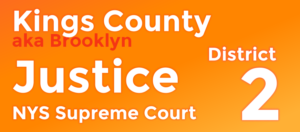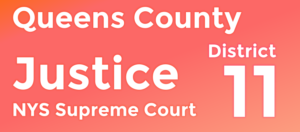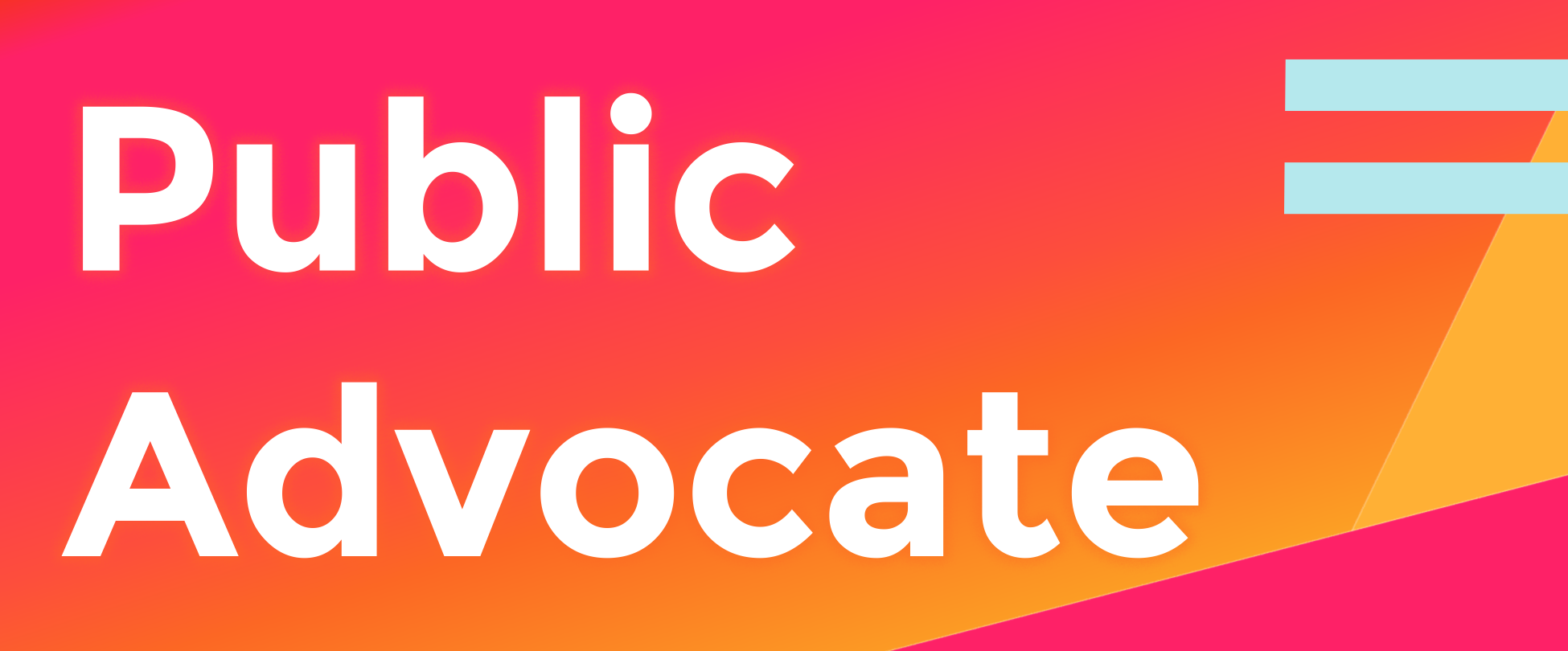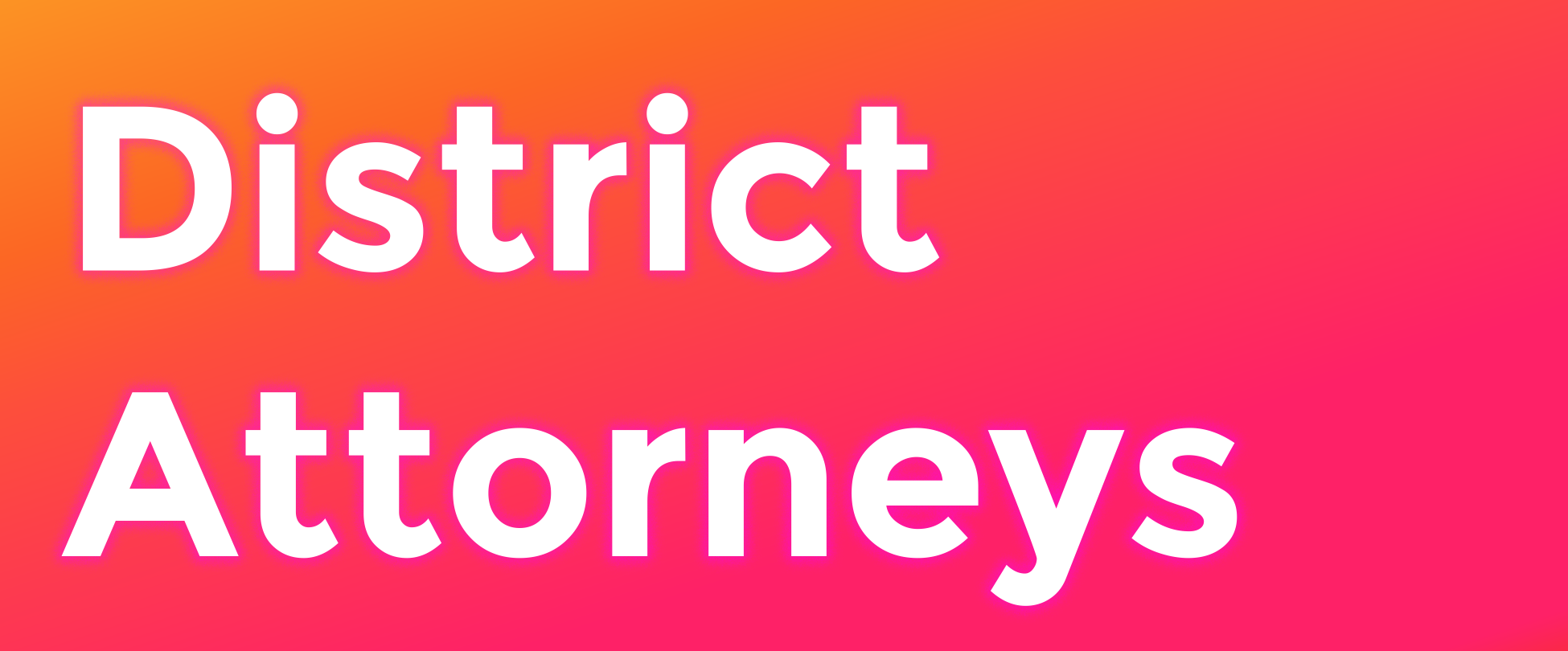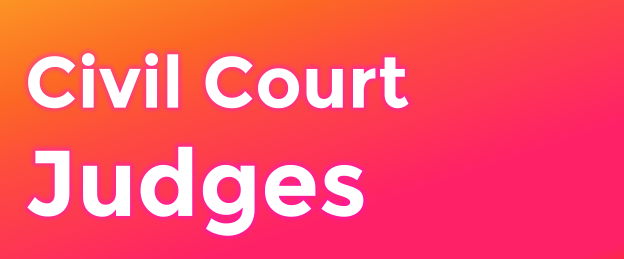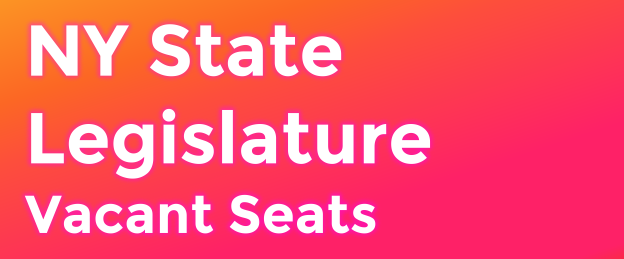
NYS Supreme Court Justices
Job Description
The Supreme Courts of NYC are part of the NY State Unified Court System, and are sub-divided into counties (corresponding to the 5 boroughs). Each county has a separate civil and criminal part of the court, but for Richmond County (Staten Island) which has these parts merged.
We only directly vote for Supreme Court judges in the General Election, as the major parties each nominate judges via a Judicial Nominating Convention. Registered voters of the major parties nominate delegates that go on to serve in the convention to select the party nominees who will be on the ballot for the General Election.
Powers and Responsibilities
click for more details!
- In the Civil Part, hears civil cases over $25,000, mostly related to:
- Medical malpractice
- Labor laws
- Motor vehicle cases
- Other torts (civil cases designed to provide relief to persons who have been harmed due to the wrongful act of others).
- In the Criminal Part, hears felony and misdemeanor cases, including:
- Burglaries
- Murder
- Conspiracies
- Weapons charges
- Drugs
- Traffic cases
Supervises and provides guidance or decisions as civil cases unfold, in these phases:
- Complaints: reviews complaints, responses, and the parties’ requests. These cases start when one person or business (the “plaintiff”) files a complaint, claiming to have been harmed by the actions of another person or business (the “defendant”). In the complaint, the plaintiff will either ask the court for:
- Damages: money to pay the plaintiff for any harm suffered;
- Injunction: a court order to prevent the defendant from doing something or to require the defendant to do something to address the problem; or
- Declaratory Judgment: a court order stating the parties’ rights under a contract or statute.
- Conferences: meetings before trials that are conducted with the judge in order to simplify the issues in the case and set a schedule
- Discovery: evidence is brought forward by each side of the case, so that both sides can prepare for trial
- Motions: requests for the court to force the parties to provide information, or issue subpoenas requiring persons to appear in court
- Trials: including instructing the jury on how to apply the law, and writing the decisions of the jury
- Judgments: also called a “decision” or “order”, where the judge or jury decide what legal consequences flow from the parties’ actions (where no jury is requested, the judge provides the decision for the case)
- Note: judges play more active roles when the parties of the lawsuit are representing themselves
Supervises and provides guidance or decisions as the criminal cases unfold, in these phases:
- Arraignment: at the arraignment, the defendant is assigned an attorney if he or she can’t afford one. The criminal complaint is read in court. This tells the defendant what the criminal charges are against him or her. The defendant then tells the court if he or she is guilty or not guilty. This is called the defendant’s plea. If the defendant pleads guilty, the defendant skips to the Sentencing step. If the defendant pleads not guilty to a felony, the case goes to the Grand Jury unless the prosecutor reduces the charge from a felony to a misdemeanor and/or violation.
- Pre-Trial: Before the trial, both sides exchange information called discovery. Either side can file pre-trial motions to ask the court for something in the case. Hearings are held on the pre-trial motions.
- Trial: the trial may be decided by a Judge or a jury. The prosecutor must prove that the defendant is guilty beyond a reasonable doubt.
- Sentencing: After a conviction or a guilty plea, the court will decide the defendant’s punishment. This is called the sentencing.
Serves either in the district where she/he was elected, or is eligible to be appointed by the Governor to the Appellate Division of the Supreme Court, or assigned by the Chief Administrator of the Courts to the Appellate Term of the Supreme Court.
- NYC elects Supreme Court Judges in five districts that correspond to the counties:
- First District – New York (Manhattan), 38
- Second District – Kings (Brooklyn), 49
- Eleventh District – Queens, 39
- Twelfth District – Bronx, 25
- Thirteenth District – Richmond (Staten Island), 3
- The Governor appoints elected Supreme Court Judges to serve in the Appellate Division, but the majority must be residents of the Department in which they serve.
- Appellate Division Judges assigned by the Chief Administrator hear appeals from the Supreme Court, Surrogate’s Court, Family Court, Court of Claims, and County Courts.
About Supreme Court Vacancies
In 2017, there are vacancies for a number of positions in four counties, so voters can select multiple candidates on the ballot.
- Bronx County – Judicial District 12: voters can “Vote for 4”
- Kings County – Judicial District 2: voters can “Vote for 2”
- New York County – Judicial District 1: voters can “Vote for 6”
- Queens County: Judicial District 11: voters can “Vote for 6”
Supreme Court + City Council Party Nominations
In 2017, two city council districts saw candidates petitioning to run for council member on party lines, then receiving nominations for Supreme Court and vacating the council race, clearing the way for other candidates to take the city council party nominations.
- In City Council District 30, Joseph Kasper petitioned as a Republican candidate for City Council, was given a Supreme Court nomination in the Republican Party for Kings County. This allowed Robert Holden, who lost the Democratic nomination, to receive the Republican line for Council District 30.
- In City Council District 43, John J. Bruno, who petitioned on as an Independence and Conservative party candidate, was given a Supreme Court nomination for the Republican and Conservative parties in Kings County. The allowed the Republican nominee, John Quaglione, to also receive the Conservative and Independence party lines for Council District 43.
A Few Facts
Official Title
Justice of the New York Supreme Court
Branch of NYC Government
Judicial
Scope of Office
County or Supreme Court District
Annual Salary
$205,100 as of April 1, 2018 (when it will be set at the same rate as Federal District Court judges)
Term Length
14 years
Term Limits
Unlimited terms
NYC's Elected Offices
Credits
Content Sources: NY Constitution NY Civil Practice Law and Rules, Article 57 NY Court of Claims Act, Section 24 NY Family Court Act, Section 1111 NY Judiciary Law Sections 140, 140-a NY Election Law, Sections 6-124, 6-126 Civil Law Self-Help Center, Overview of a Civil Case NYS Commission on Legislative, Judicial and Executive Compensation, Final Report on Judicial Compensation, approved December 2015 New York State Unified Court System NYC Bar Association Council on Judicial Administration, Judicial Selection Methods in the State of New York: A Guide to Understanding and Getting Involved in the Selection Process, 2014 United States Courts, Judicial Compensation
Team Members Involved in the Production of this Page:


